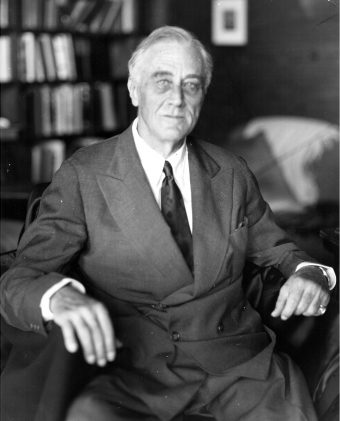The Plot Against President Franklin D. Roosevelt
 Conspiracy theories can be amusing to read because they’re usually so bizarre and far-reaching that they couldn’t possibly be true. What’s even more fun is a conspiracy that’s not a theory at all. Here’s one that actually happened.
Conspiracy theories can be amusing to read because they’re usually so bizarre and far-reaching that they couldn’t possibly be true. What’s even more fun is a conspiracy that’s not a theory at all. Here’s one that actually happened.
ALL THE RAGE IN EUROPE
In the 1930s, many Western countries suffered severe economic depressions. The need to prevent unrest and establish control was so desperate that in Italy, Germany, and Spain, military-backed coups installed fascist governments. In that system a centralized government, led by a sole dictator, holds all the power and the individual citizen has little recourse. Fascist governments readily use force to quell what they perceive as threats, such as labor unions. Notable fascist dictators of the 1930s: Benito Mussolini in Italy, Francisco Franco in Spain, and Adolf Hitler in Germany.
In another country, a fascist coup was attempted not by the military, but by a group of powerful businessmen and politicians. They wanted to overthrow the democratically elected head of state through blackmail and threats of violence and replace him with a puppet dictator who would serve their interests. That country was the United States.
RAW DEAL?
Franklin D. Roosevelt was elected president in 1932 largely on the basis of his New Deal, a far-reaching series of reforms designed to stimulate the economy out of the Great Depression. Roosevelt’s plans weren’t universally popular—giving control of economic matters to the government instead of business in a free-market economy was viewed by many as communism, especially Social Security, which was perceived as the needy getting “something for nothing.”
But the crux of the New Deal was job creation. Roosevelt proposed more than 10 new government agencies such as the Works Progress Administration, the Civilian Conservation Corps, the Civil Works Administration, and the Tennessee Valley Authority, that would oversee construction and beautification projects and generate millions of new jobs.
THE PLOT BEGINS
Business leaders were especially opposed to the National Recovery Administration, which set minimum wages and reduced the work week, even in the private sector. Used to paying their workers whatever they wanted (for as much work as they wanted), barons of industry stood to lose millions.
A group of anti-Roosevelt business leaders and politicians (Democrats and Republicans) formed an organization in 1933 called the American Liberty League (ALL), dedicated to “fostering the right to work, earn, save, and acquire property.” In other words, they advocated individual wealth-building and villainized welfare. The ALL was so dedicated to that goal that it would do whatever was necessary to secure their wealth. That included staging a militia-backed coup to force Roosevelt out of office and replace him with a pro-business dictator.
BUSINESS CLASS
In June 1933, a number of ALL members met to discuss the specifics of removing Roosevelt. Among those reported to be in attendance were:
- Irénée Du Pont, president of the DuPont chemical company
- Dean Acheson, the undersecretary of the Treasury, a position to which he was appointed by Roosevelt
- Al Smith, the 1928 Democratic presidential candidate
- Grayson Murphy, a board member of several companies, including Goodyear, Bethlehem Steel, and the J. P. Morgan & Co. banking conglomerate
- Robert Clark, one of Wall Street’s wealthiest investors
- William Doyle, commander of the Massachusetts department of the American Legion, a veterans’ service and political organization. The 300,000 Massachusetts members were almost exclusively veterans of World War I.
- Gerald MacGuire, a bonds investor and commander of the Connecticut department of the American Legion
- Prescott Bush, an influential banker and a board member of several corporations (later, a Republican Senator from Connecticut from 1952 to 1962, father of George H. W. Bush, and grandfather of George W. Bush)
The group concocted a plan to force Roosevelt to create a new cabinet position called the Secretary of General Affairs, which would be filled by a person of the ALL’s choosing. Next, they’d force Roosevelt to admit to the public that he had been crippled by polio (not widely known because he was rarely photographed in his wheelchair). The knowledge that the president couldn’t walk or even stand without assistance would destroy all trust in his ability to pull the country out of its economic mess, and the backlash would force Roosevelt to shift authority to the Secretary of General Affairs.
In all likelihood, of course, Roosevelt would refuse to meet the ALL’s demands to create the new position, confess his condition, and transfer power. Part two of the plan: If Roosevelt refused, Doyle and MacGuire would activate their American Legion brigades to form a militia of more than 500,000 who would then storm Washington, D.C., and take power by force.
THE BUTLER DID IT
For the American people and 500,000 soldiers to go along with a plan to depose a president, the ALL knew that whoever they chose to be the Secretary of General Affairs would have to be popular with both the military and the general public. So, acting on behalf of the plotters, MacGuire approached Smedley Butler, a major general in the Marine Corps and the most decorated Marine in history at that point. Butler was as loved by the military and respected by the general public just as later generals like Dwight Eisenhower, Douglas MacArthur, and Colin Powell would be. That’s because in 1932, when World War I veterans marched on Washington to lobby Congress over still-unpaid combat bonuses from 15 years earlier, Butler publicly supported them and even gave a speech encouraging them to fight for what was rightfully theirs.
CLANDESTINE MEETING
MacGuire visited Butler at his home in Newton Square, Pennsylvania, in June 1933. They met for just 30 minutes, but MacGuire gave him the complete details of the plot, including the names of those involved and a promise of $3 million in financial support. Butler asked MacGuire why something as drastic as a coup was necessary. MacGuire said that it was because Roosevelt’s social programs proved he was a Communist. “We need a fascist government in this country to save the nation from the Communists who want to tear it down and wreck all that we have built,” Butler later said MacGuire told him.
Butler agreed and told MacGuire he was in…except that he really wasn’t. What the ALL members hadn’t taken into consideration was that the combat bonus protests of the previous summer, which had made Butler beloved among soldiers, ended when President Herbert Hoover sent in the cavalry to break it up. Butler was so appalled by this treatment of the WWI veterans that he renounced Hoover and the Republican party, became a Democrat, and actively campaigned for Roosevelt in the 1932 election.
PLOTLESS
After speaking with MacGuire, Butler promptly reported the meeting and the brewing fascist coup to the McCormack-Dickstein Committee, the congressional committee in charge of investigating threats to the government, such as fascist coups. (In the 1940s, the committee would try to root out Communists under a different, somewhat ironic, name: the House Un-American Activities Committee.)
Butler gave his testimony to the committee between July and November 1934. Nearly all of the conspirators Butler named were asked to testify. But since they weren’t subpoenaed, merely asked, they never showed up. The only exception was Gerald MacGuire, and he denied everything. In its final report, the committee officially stated that it believed Butler:
Your committee received evidence showing that certain persons had made an attempt to establish a fascist government in this country. There is no question that these attempts were discussed, were planned, and might have been placed in execution when and if the financial backers deemed it expedient. This committee received evidence from Maj. Gen. Smedley D. Butler (retired), who testified before the committee as to conversations with one Gerald C. MacGuire in which the latter is alleged to have suggested the formation of a fascist army under the leadership of General Butler.
But the findings—and Butler’s credibility—were undercut when the report was released to the public with the names of the conspirators blacked out. The names were never officially released, and no one associated with the “plot” was ever held accountable.
COUP DE-TAH-TAH
So why didn’t the federal government prosecute the plotters? At the time, Roosevelt was trying hard to get his New Deal programs passed through Congress. Releasing the names of the government officials and appointees involved would have undermined Roosevelt’s authority and made him look like a weak leader. In fact, it may have been Roosevelt himself who suggested that the McCormack-Dickstein Committee withhold the conspirators’ names and not pursue charges…provided the plotters agreed to stop speaking out publicly against his social and relief programs.
The compromised report, coupled with the altogether absurd nature of the idea of a fascist coup in America (even if it was true), led to little media coverage. The New York Times and Time reported on the committee’s findings, but dismissed Butler’s claims as rumor and hearsay.
How serious were the conspirators? The idea never got past the planning stages, and the conspirators may have met only that once. When news that Butler had turned informant got out, the plot crumbled. But they did have one “backup” plan—shortly after MacGuire met with Butler, MacGuire also approached James Van Zandt, the head of the Veterans of Foreign Wars office, to be the Secretary of General Affairs should Butler decline. After Butler revealed the plot to the congressional committee, Van Zandt told reporters his story, lending Butler’s story some credence, but that’s as far as it went.
IRONIC POSTSCRIPT
The American Liberty League which, in addition to proposing fascist coups, operated as a legitimate pro-capitalist organization. It folded in 1940. That same year, Franklin Roosevelt was elected to his record third presidential term. Roosevelt was reelected again in 1944, but in the same national election, Republicans took control of Congress from the Democrats, gaining a majority in both the Senate and the House. After Roosevelt’s death five months after the election, the conservative government was eager to start anew, and in 1951 passed the 22nd Amendment to the Constitution, which limited future presidents to two terms. Why? Many senators and representatives feared that a president who held office for too long could become a dictator.
 This article is reprinted with permission from Uncle John’s Unsinkable Bathroom Reader. Uncle John and his crack staff of writers prove that after more than two decades in the business, they’re still at the top of their game. Who else but Uncle John could tell you about the tapeworm diet, 44 things to do with a coconut, and the history of the Comstock Lode? Uncle John rules the world of information and humor, so get ready to be thoroughly entertained.
This article is reprinted with permission from Uncle John’s Unsinkable Bathroom Reader. Uncle John and his crack staff of writers prove that after more than two decades in the business, they’re still at the top of their game. Who else but Uncle John could tell you about the tapeworm diet, 44 things to do with a coconut, and the history of the Comstock Lode? Uncle John rules the world of information and humor, so get ready to be thoroughly entertained.
Since 1987, the Bathroom Readers’ Institute has led the movement to stand up for those who sit down and read in the bathroom (and everywhere else for that matter). With more than 15 million books in print, the Uncle John’s Bathroom Reader series is the longest-running, most popular series of its kind in the world.
If you like Today I Found Out, I guarantee you’ll love the Bathroom Reader Institute’s books, so check them out!
| Share the Knowledge! |
|




